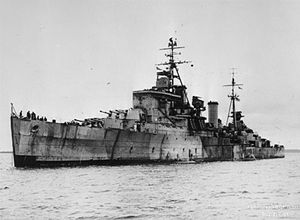Minotaur-class cruiser (1943)

|
|
| Class overview | |
|---|---|
| Name: | Minotaur-class cruiser |
| Operators: | |
| Preceded by: | Crown Colony class |
| Succeeded by: | Tiger class |
| In commission: | 1944 - 1958 |
| Planned: | 8 (9?) |
| Completed: | 3 |
| Cancelled: | 5 (6?) |
| General characteristics | |
| Type: | Light cruiser |
| Displacement: |
|
| Length: | 555.5 ft (169.3 m) |
| Beam: | 63 ft (19 m) (Superb: 64 ft (20 m)) |
| Draught: | 17.25 ft (5.26 m) |
| Installed power: | 72,500 shp (54.1 MW) |
| Propulsion: |
|
| Speed: | 31.5 knots (58.3 km/h) |
| Range: |
|
| Complement: | 867 |
| Armament: |
|
| Armour: | |
The Minotaur class of light cruisers of the British Royal Navy, also known as the Swiftsure class, was designed as a modified version of the Crown Colony class incorporating war modifications and authorised in 1941. However, in spite of the heavy toll of cruisers in that year and the following one, the building of this new class had a relatively low priority and only three were completed by end of World War II. They played no significant part in the Second World War, though Swiftsure, as flagship of the British Pacific Cruiser Squadron, was selected by Admiral Cecil Harcourt to hoist his flag for the Japanese surrender at Hong Kong. Superb was completed to a slightly different design.
The class was originally to have consisted of eight ships, laid down in 1943, but by the end of World War II only Minotaur, Swiftsure, and Superb were complete, whilst the others were laid up. Minotaur was transferred to the Royal Canadian Navy and renamed Ontario. While the basic specifications and original armament were only a slight enlargement of the Crown Colony class with an extra twin 4-inch turret, the Minotaurs did represent a substantial advance towards more sophisticated weapon control and integration of command and control and AIO and developments towards operation room control of fighting ships. By 1944 the 7 Minotaur cruisers under construction represented four different groups, which were significantly different that they should probably be regarded as four different classes of cruiser. Swiftsure introduced the reliable 274 lock and follow radar, which increased the accuracy of the main armament to get on target fast. The second Superb extended this more advanced radar with the addition of 275 for anti aircraft fire control, although Superb′s version lacked the flyplane or the accurate finishing in the version fitted to later Battle-class destroyers. The third group of Minotaurs, the Tigers, were being built from quite early in their evolution with a different main battery consisting of three triple MK 24 6 inch turrets, which were DP, elevating to 60 degrees, and which automatically tracked and followed targets under 274/275 radar control. These guns and those for Hawke, the fourth Tiger were nearly complete by late 1946 and were stored at Rosyth, until the late 1950s, as alternatives to the Mk 26 automatic twin 6 guns that were eventually fitted. Hawke represents a further development, surprisingly scrapped on the slip in late 1945, with its boilers and machinery complete, and its guns nearly finished.
...
Wikipedia
